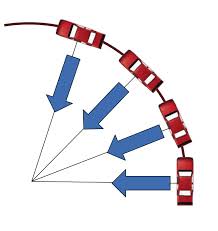Friction and its Significance ::
Friction can be understood very easily with the help of an example...
Case (1) :: Suppose we are going in a desert area on foot or in a vehicle
Case (2) :: Suppose you are going on a road where small stones are crushed and laid down on the road
Case (3):: Suppose you are going on a plain road
Case (4) :: Suppose you are walking on tiles which are polished
Can you notice the difference in four cases then the topic of friction is very easy if not notice whatever you can experience in your day to day life
The repulsion ( force) we experience decreases from case (1) - case (4)
The Concept of friction can be understood well when we relate it to real life situations.
Friction :: It is the force which opposes the motion of an object or a person when force is applied.
It arises due to the surfaces in contact and the decreasing surface area of contact decreases the friction.
The same you can observe when a block of same area is cut in the shape of a rectangle and a circle, if you try to drag them along the edges i.e.,along the diagonal to the surface then the circular shape will move easily compared to the rectangular one.
The friction is the force which is responsible for the way we are walking,running or any other activity we are doing with our legs.
The effect of friction can be reduced to a large extent by applying lubricants...
Suppose you are walking on tile floor and pour oil in it and try to put your leg on that..
Never do this because you will end up with injuries because the frictional force is reduced which causes you to drag along the surface which is not a good thing.
Friction can be understood very easily with the help of an example...
Case (1) :: Suppose we are going in a desert area on foot or in a vehicle
Case (2) :: Suppose you are going on a road where small stones are crushed and laid down on the road
Case (3):: Suppose you are going on a plain road
Case (4) :: Suppose you are walking on tiles which are polished
Can you notice the difference in four cases then the topic of friction is very easy if not notice whatever you can experience in your day to day life
The repulsion ( force) we experience decreases from case (1) - case (4)
The Concept of friction can be understood well when we relate it to real life situations.
Friction :: It is the force which opposes the motion of an object or a person when force is applied.
It arises due to the surfaces in contact and the decreasing surface area of contact decreases the friction.
The same you can observe when a block of same area is cut in the shape of a rectangle and a circle, if you try to drag them along the edges i.e.,along the diagonal to the surface then the circular shape will move easily compared to the rectangular one.
The friction is the force which is responsible for the way we are walking,running or any other activity we are doing with our legs.
The effect of friction can be reduced to a large extent by applying lubricants...
Suppose you are walking on tile floor and pour oil in it and try to put your leg on that..
Never do this because you will end up with injuries because the frictional force is reduced which causes you to drag along the surface which is not a good thing.
































